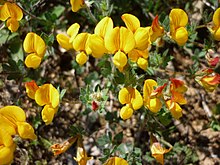Lotus (genus)
| Lotus | |
|---|---|
 |
|
| bird's-foot trefoil Lotus corniculatus |
|
| Scientific classification | |
| Kingdom: | Plantae |
| (unranked): | Angiosperms |
| (unranked): | Eudicots |
| (unranked): | Rosids |
| Order: | Fabales |
| Family: | Fabaceae |
| Subfamily: | Faboideae |
| Tribe: | Loteae |
| Genus: |
Lotus L. |
| Species | |
|
Between 70–150; see text |
|
| Synonyms | |
|
|
Between 70–150; see text
Lotus, derived from lota (a small, usually spherical water vessel of brass, copper or plastic used in parts of South Asia), is a genus that includes most bird's-foot trefoils (also known as bacon-and-eggs) and deervetches and contains many dozens of species distributed world-wide. Depending on the taxonomic authority, roughly between 70 and 150 are accepted. Lotus is a genus of legume and its members are adapted to a wide range of habitats, from coastal environments to high altitudes. Most species have leaves with five leaflets; two of these are at the extreme base of the leaf, with the other three at the tip of a naked midrib. This gives the appearance of a pair of large stipules below a "petiole" bearing a trefoil of three leaflets – in fact, the true stipules are minute, soon falling or withering. Some species have pinnate leaves with up to 15 leaflets. The flowers are in clusters of three to ten together at the apex of a stem with some basal leafy bracts; they are pea-flower shaped, usually vivid yellow, but occasionally orange or red. The seeds develop in three or four straight, strongly diverging pods, which together make a shape reminiscent of the diverging toes of a small bird, leading to the common name "bird's-foot".
The genus Lotus is currently undergoing extensive taxonomic revision. All species native to California (30 spp.) have been recently moved to the genera Acmispon and Hosackia in the second edition of The Jepson Manual.
Lotus species are used as food plants by the larvae of some Lepidoptera species. Several species are culvivated for forage, including L. corniculatus, L. glaber, and L. pedunculatus. They can produce toxic cyanogenic glycosides which can be potentially toxic to , but also produce tannins, which are a beneficial antibloating compound.
...
Wikipedia
